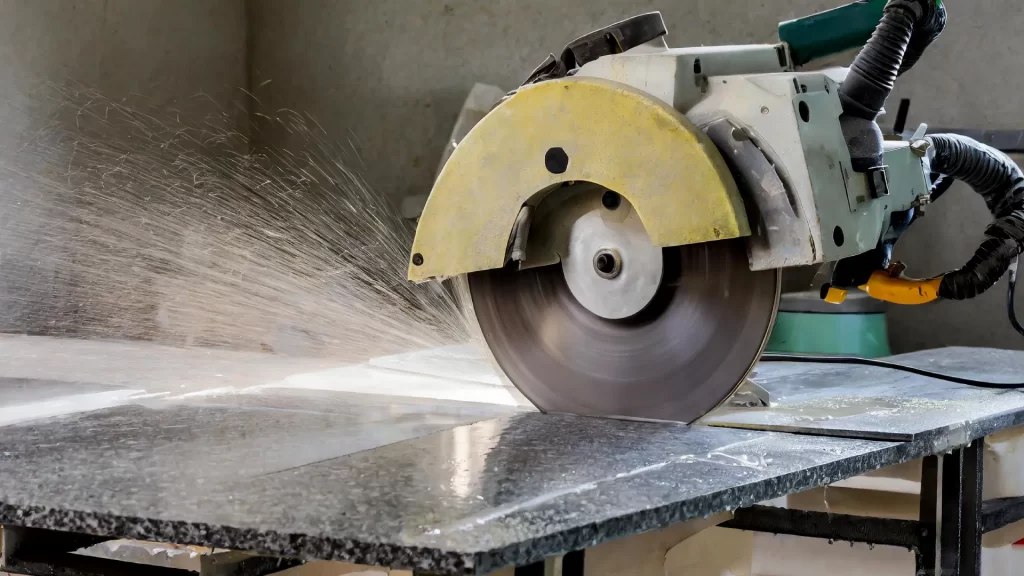Cutting granite worktops can seem like a daunting task due to the material’s hardness and weight. However, with the right tools, techniques, and safety precautions, it’s a manageable DIY project. This guide will walk you through the process of cutting granite worktops, from preparation to finishing touches.
Understanding Granite
Granite is a natural stone that is renowned for its durability and aesthetic appeal. It is composed of quartz, feldspar, and mica, which give it its unique appearance and hardness. Due to these properties, granite is a popular choice for kitchen and bathroom worktops.
Tools and Materials Needed
Before you begin cutting granite, ensure you have the following tools and materials:
- Diamond Blade Circular Saw: A circular saw fitted with a diamond blade is essential for cutting granite.
- Measuring Tape: Accurate measurements are crucial for a precise cut.
- Masking Tape: Used to mark the cutting line and protect the granite surface.
- Clamps: To secure the granite in place during cutting.
- Safety Gear: Safety goggles, dust mask, ear protection, and gloves.
- Water Source: To keep the blade cool and reduce dust.
- Polishing Pads: For smoothing the edges after cutting.
- Workbench or Saw Horses: To support the granite slab.
Preparation
Measure and Mark
- Measure the Area: Measure the area where the granite worktop will be installed. Double-check your measurements to ensure accuracy.
- Mark the Cutting Line: Use masking tape to mark the cutting line on the granite slab. The tape will help prevent chipping along the cut line. Use a straightedge to draw the line clearly.
Set Up the Workspace
- Secure the Granite: Place the granite slab on a stable workbench or saw horses. Ensure it is well-supported and won’t shift during cutting.
- Clamp the Granite: Use clamps to secure the granite in place. Make sure the clamps are positioned away from the cutting line.
Cutting the Granite
Safety First
Before you start cutting, put on your safety gear: goggles, dust mask, ear protection, and gloves. Granite dust can be harmful if inhaled, and the noise from the saw can be quite loud.
Cutting Process
- Set Up the Saw: Attach a diamond blade to your circular saw. Ensure the blade is suitable for cutting stone and is properly secured.
- Cooling the Blade: Use a water source to keep the blade cool. Some saws have a water attachment; if not, you can have someone spray water onto the blade as you cut.
- Start Cutting: Begin by making a shallow cut along the marked line. This initial pass should be about 1/8 inch deep to create a guide.
- Deepen the Cut: Gradually deepen the cut by making multiple passes along the guide line. Do not rush; let the saw do the work to avoid overheating the blade or cracking the granite.
- Cut Through the Slab: Continue making passes until you have cut through the entire thickness of the slab. Keep the blade cool with water throughout the process.
Polishing the Edges
After cutting, the edges of the granite may be rough. Use polishing pads to smooth and refine the edges.
- Start with Coarse Grit: Begin with a coarse grit pad to remove any large imperfections and smooth the edge.
- Progress to Finer Grits: Gradually move to finer grit pads to achieve a polished finish. Wipe the edges clean with a damp cloth between each stage.
- Final Polish: Use a high-grit pad for the final polish, ensuring the edges match the polished surface of the worktop.
Installing the Granite Worktop
Once the granite is cut and polished, it’s ready for installation.
- Position the Worktop: Carefully place the granite worktop in position. Ensure it fits properly and adjust as needed.
- Secure the Worktop: Use a strong adhesive or silicone sealant to secure the worktop to the base cabinets. Apply the adhesive evenly to ensure a strong bond.
- Seal the Edges: Seal any seams or joints with a colour-matched silicone sealant to prevent water ingress and to create a seamless look.
Final Tips
- Practice Safety: Always prioritise safety by wearing the appropriate gear and working in a well-ventilated area.
- Take Your Time: Rushing the cutting process can lead to mistakes or damage. Take your time to ensure a precise and clean cut.
- Seek Help: Granite slabs are heavy and difficult to manoeuvre alone. Seek assistance when lifting and positioning the worktop.
Conclusion
Cutting granite worktops requires careful planning, the right tools, and meticulous execution. By following this guide, you can achieve professional results and enjoy the beauty and durability of granite in your home. Whether you’re renovating a kitchen or bathroom, the effort you put into cutting and installing granite worktops will pay off with a stunning, long-lasting finish.

